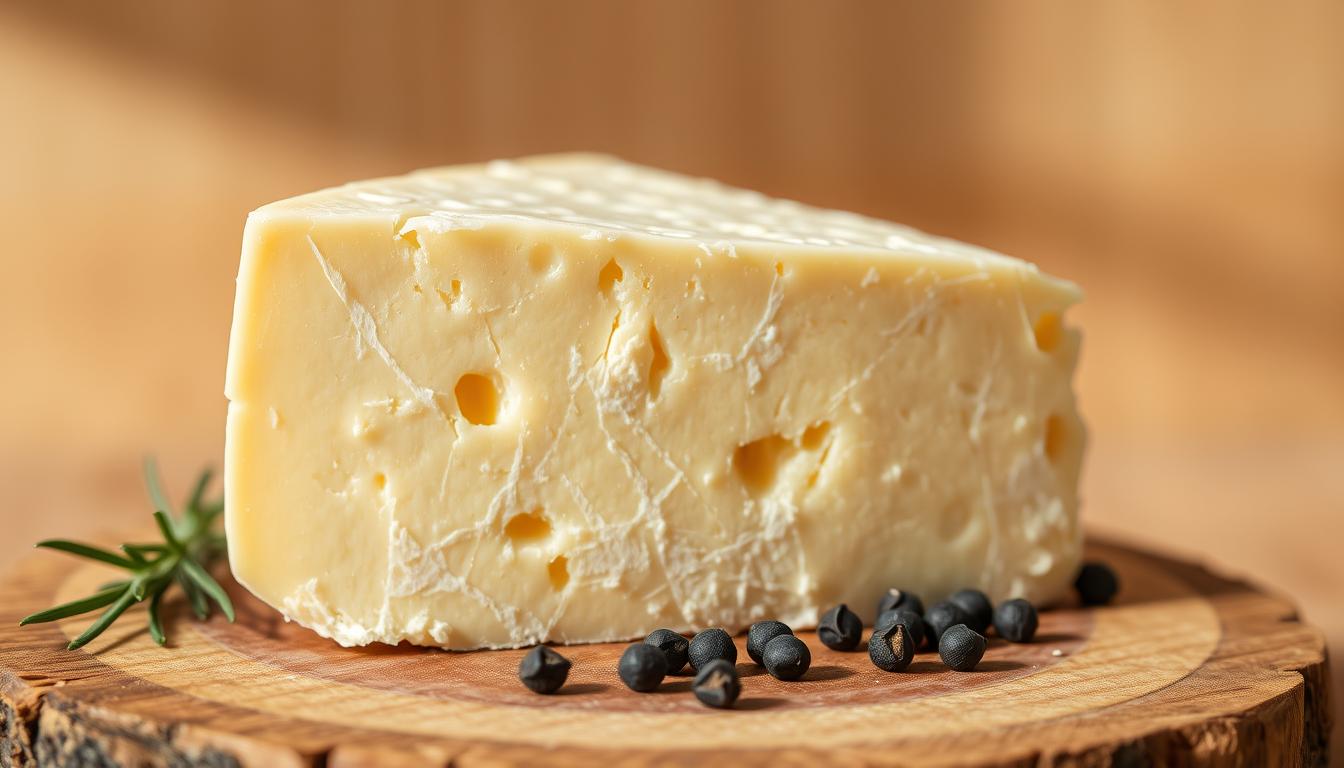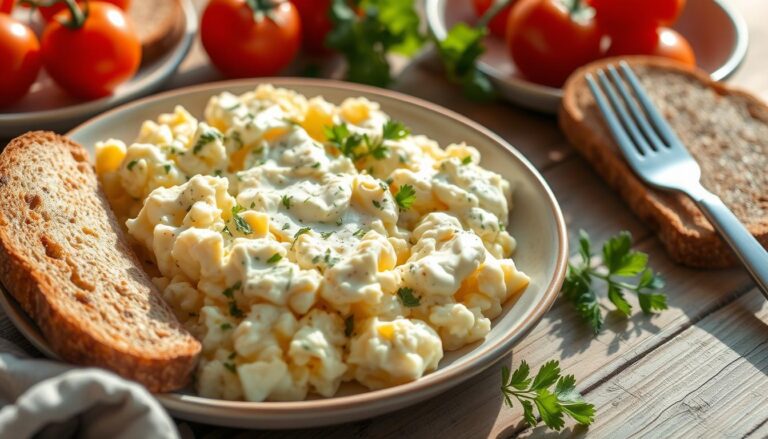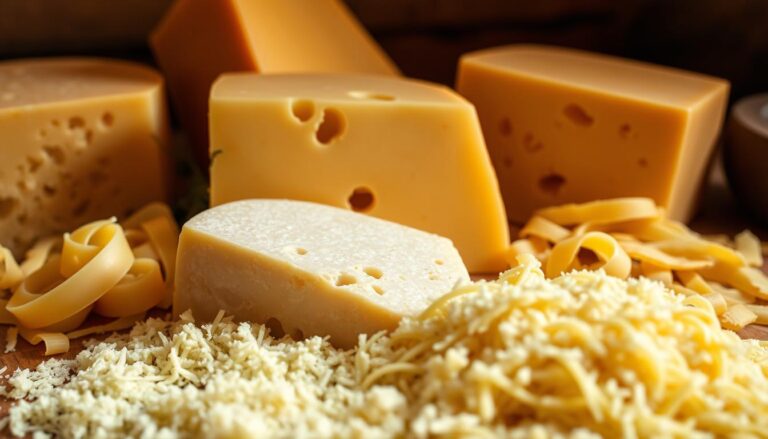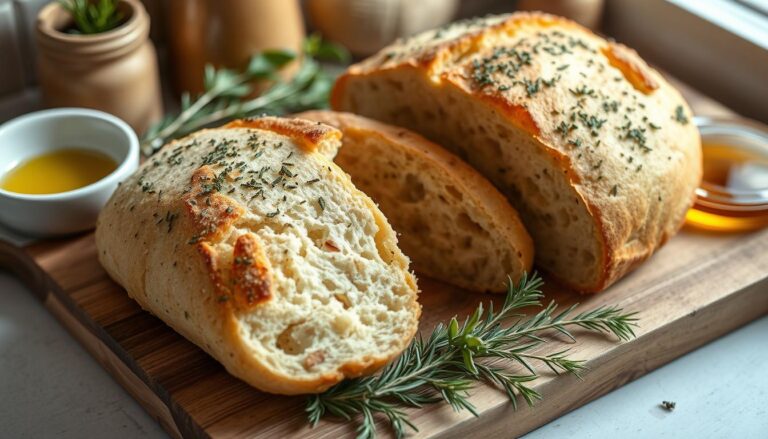Pecorino Romano: A Timeless Italian Cheese Delight
Pecorino Romano is a classic Italian cheese made from sheep’s milk. It’s known worldwide for its long history and quality. This cheese is a must-have for anyone who loves cheese. It’s great for making pasta dishes better or for exploring Italian cheeses.
When comparing Pecorino Romano to Parmesan, it stands out in flavor and texture. For more info on Pecorino Romano, check out Pecorino Romano.
Pecorino Romano has been made for over 2,000 years, starting in ancient Rome1. Its sharp, salty taste is stronger than Parmesan’s1. It’s firm, making it perfect for grating over pasta, salads, or in recipes. Knowing its history and uses in cooking helps you enjoy its timeless charm.
Key Takeaways
- Pecorino Romano is a classic Italian hard cheese with a distinctive sheep’s milk profile.
- It has been produced for over 2,000 years, tracing its origins back to ancient Rome1.
- Pecorino Romano is protected under the European Union’s PDO (Protected Designation of Origin) status, ensuring it meets strict production criteria1.
- Its sharp, salty flavor is more pronounced than that of Parmesan cheese1, making Pecorino Romano vs Parmesan a notable comparison.
- Pecorino Romano is a great source of protein and calcium, though specific nutritional values are not provided2.
- It’s perfect for grating over pasta, salads, or using in recipes, and can be stored by wrapping it in parchment or wax paper, then in plastic wrap, and storing it in the refrigerator1.
The Rich History of Pecorino Romano
Pecorino Romano has a long history, dating back over 2000 years3. It started in ancient Rome. This cheese was great for soldiers because it lasted a long time.
Knowing about Pecorino Romano history helps us see its importance in Italian food. It’s a big part of Italian culture.
Pecorino Romano was first made in Lazio, but now most comes from Sardinia4. It’s been a Protected Designation of Origin (PDO) since 19964 and3. This means its quality and authenticity are guaranteed. To learn more, visit Pecorino Romano history.
The cheese ages for at least 5 months, sometimes up to 8 months4 and3. This aging gives it a unique taste and texture. It’s perfect for pasta and salads.
Some interesting facts about Pecorino Romano include:
- It started in Lazio, Italy, but most is now made in Sardinia4.
- It’s mainly used in pasta dishes in central and southern Italy4.
- It has 385 calories per 100 grams3.
What Makes Pecorino Romano Unique
Pecorino Romano is a special Italian cheese known for its robust and tangy flavor. It has a crumbly texture that makes every bite delightful5. The cheese’s unique taste and texture come from aging it for at least five months6.
This aging process makes it stand out among other Italian cheeses. It gives the cheese its distinct flavor and texture.
The Pecorino Romano Cheese Taste and Texture are shaped by its production and the quality of the milk. The cheese is mainly made from the milk of free-grazing sheep. This contributes to its unique flavor5.
The aging process for Pecorino Romano lasts between 5 to 8 months. During this time, the cheese develops its sharp and tangy bite6.
Some key characteristics of Pecorino Romano include:
* A robust and tangy flavor profile
* A crumbly texture that adds a delightful dimension to every bite
* A production process that involves aging the cheese for a minimum of five months
* A unique flavor profile shaped by the quality of the milk used and the cheese’s production process56
Pecorino Romano has been made in Italy for over 2,000 years. Most of it is produced in Sardinia6. It’s classified as a Protected Designation of Origin (PDO) cheese, ensuring high quality6.
Whether you’re looking to add a tangy kick to pasta or a rich flavor to salads, Pecorino Romano is a great choice. It offers a unique Pecorino Romano Cheese Taste and Texture that’s sure to please.
The Art of Making Pecorino Romano
Pecorino Romano cheese is made through a traditional process. It starts with carefully choosing sheep’s milk and aging it for a long time7. The milk comes from local sheep breeds, known for their high-quality milk. It’s collected only from November to June7.
This careful milk selection makes Pecorino Romano cheese strong and flavorful. It has a unique taste and texture.
The aging process is key to Pecorino Romano’s flavor and texture. The cheese ages for at least five months for table cheese and eight months for grating varieties7. This aging makes it perfect for grating or in recipes.
Producers follow strict quality standards. They use traditional methods to ensure the cheese meets high quality standards.
Several factors make Pecorino Romano special. These include:
- The type of sheep’s milk used, with the Sardo breed producing one liter of milk per day for seven to eight months8
- The aging environment, such as the caves used for Fossa cheese, which can influence the transformation of cheese flavor and texture8
- The introduction of Sardinian shepherds in the 1960s, which significantly changed Pecorino production in the Val d’Orcia region8
Making Pecorino Romano is a traditional art. It requires attention to detail and a commitment to quality. By understanding what makes it unique, we can appreciate the craftsmanship and tradition behind this iconic Italian cheese7.
Pecorino Romano vs Parmesan: Understanding the Differences
Pecorino Romano and Parmesan are two famous Italian cheeses. They have some similarities but also many differences. Pecorino Romano is made from sheep’s milk and tastes sharper and saltier than Parmesan, which is made from cow’s milk and tastes nutty and fruity9. Pecorino Romano ages for 5-8 months, while Parmesan ages for at least 12 months9.
Pecorino Romano is firmer and crumblier than Parmesan. This makes it great for grating over pasta or salads. For more on their differences, check out this website. Also, Pecorino Romano has a higher milk fat content than Parmigiano Reggiano, with 32% compared to about 30%10.
Here are some key differences between Pecorino Romano and Parmesan:
- Flavor: Pecorino Romano has a sharper and saltier flavor, while Parmesan has a nutty and fruity taste
- Texture: Pecorino Romano is firmer and more crumbly, while Parmesan is smoother
- Aging process: Pecorino Romano is aged for 5-8 months, while Parmesan is aged for a minimum of 12 months
Knowing the differences between Pecorino Romano and Parmesan is key for cheese lovers. It lets you enjoy each cheese’s unique qualities and use them correctly9. By understanding their flavors and textures, you can improve your cooking and dining.
Flavor Profile and Texture Characteristics
Pecorino Romano cheese is famous for its unique taste and texture. It has a sharp, salty flavor with tangy and sweet notes11. The cheese is firm and granular, ideal for grating over pasta or salads12.
As it ages, Pecorino Romano gets sharper and more robust13. The aging process lasts 8 to 12 months, making it hard and bold11. It’s made from sheep’s milk, with a fat content of 36% to 50%13. The cheese is salted several times to enhance flavor and preservation13.
Pecorino Romano is a favorite for grating over pasta, like carbonara and cacio e pepe11. It’s also high in saturated fats, so it should be eaten in moderation11. Pecorino Romano is a key ingredient in Italian dishes, loved by cheese lovers12.
Essential Tips for Storing Your Pecorino Romano
To keep your Pecorino Romano fresh, store it right. Keep it cool and dry, wrapped in parchment or wax paper to avoid moisture14. This prevents drying out or mold growth. Hard cheeses like Pecorino Romano can last weeks to months if stored well14.
Here are some tips for storing Pecorino Romano:
- Keep it away from strong-smelling foods, as it can absorb odors easily
- Store it in the fridge to extend its shelf-life, as recommended by dairy lab scientists and cheese experts14
- Wrap it in cheese paper or bee’s wrap if a Cheese Grotto is not available14
When storing Pecorino Romano, keep humidity high to keep it fresh14. Store it in the vegetable drawer of the fridge to keep it moist14. By following these tips, you can enjoy your Pecorino Romano longer and appreciate its unique taste and texture. Pecorino Romano can last 1–2 months in the fridge when wrapped right15.
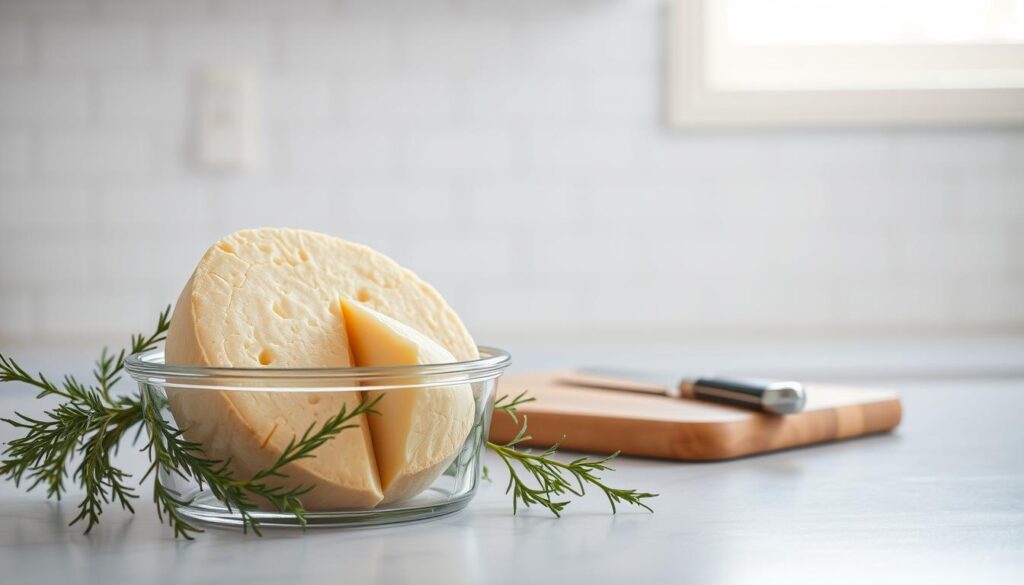
Always check the cheese for spoilage before eating it. With the right storage and care, you can enjoy Pecorino Romano’s rich flavor and texture for a longer time15.
Culinary Applications in Modern Cooking
Pecorino Romano is a versatile cheese used in many dishes. It’s a key part of Italian cuisine, found in classics like Cacio e Pepe and Carbonara. It also goes well with different wines, adding to any meal.
Some top Best Pasta Dishes with Pecorino Romano include spaghetti carbonara and fettuccine Alfredo. These dishes show off the cheese’s sharp, tangy taste. Pecorino Romano is also used in soups, salads, and sauces.
Here are some popular ways to use Pecorino Romano in modern cooking:
- Pasta dishes: Pecorino Romano is a classic pairing for spaghetti, fettuccine, and other pasta shapes.
- Soups and salads: The cheese adds a salty, tangy flavor to soups and salads, making it a great addition to dishes like minestrone and caprese.
- Sauces and marinades: Pecorino Romano can be used to make a variety of sauces and marinades, including carbonara sauce and Italian dressing.
Pecorino Romano is a staple in traditional Italian dishes, used in pasta, soups, and salads16. It’s heavily salted to boost flavor and keep it fresh. This makes it perfect for anyone wanting to make authentic Italian dishes.
Buying Guide: Selecting Quality Pecorino Romano
Looking to buy Pecorino Romano? A Pecorino Romano buying guide can help you find the best one. Italy makes 25,000 tons of this cheese every year17. Knowing what to look for is key.
First, check for the Protected Designation of Origin (PDO) mark. This ensures the cheese is made the traditional way in places like Lazio, Sardinia, and Tuscany18.
When picking a quality Pecorino Romano, look for the PDO mark and the producer’s name. The cheese must come from sheep grazing on grass19. Also, it should have aged for at least five months to be sold whole, or eight months for grated cheese19.
Some important things to look for in Pecorino Romano include:
- It’s high in protein and doesn’t have lactose19
- It has a strong, nutty flavor with a spicy hint19
- It’s made the old-fashioned way, by hand, by skilled cheesemakers19
By keeping these tips in mind, you can pick a top-notch Pecorino Romano. It’s perfect for traditional Italian dishes or as a cheese substitute. A quality Pecorino Romano will elevate your cooking.
Nutritional Benefits and Dietary Considerations
Pecorino Romano is a cheese that’s good for you when eaten in small amounts. It has lots of calcium, sodium, zinc, selenium, and phosphorus in just 100g20. It also has 25g of protein per 100g, which is great for a healthy diet21.
This cheese has only 3.57g of carbs per 100g, which is low21. It’s perfect for those on a ketogenic diet, which limits carbs to 50g a day21. It’s also packed with calcium and phosphorus, which are good for your bones21.
But, it’s important to remember that Pecorino Romano is high in saturated fat and sodium21. So, it’s best to eat it in small amounts as part of a balanced diet. For more info, check out this website or learn about Requeson cheese.
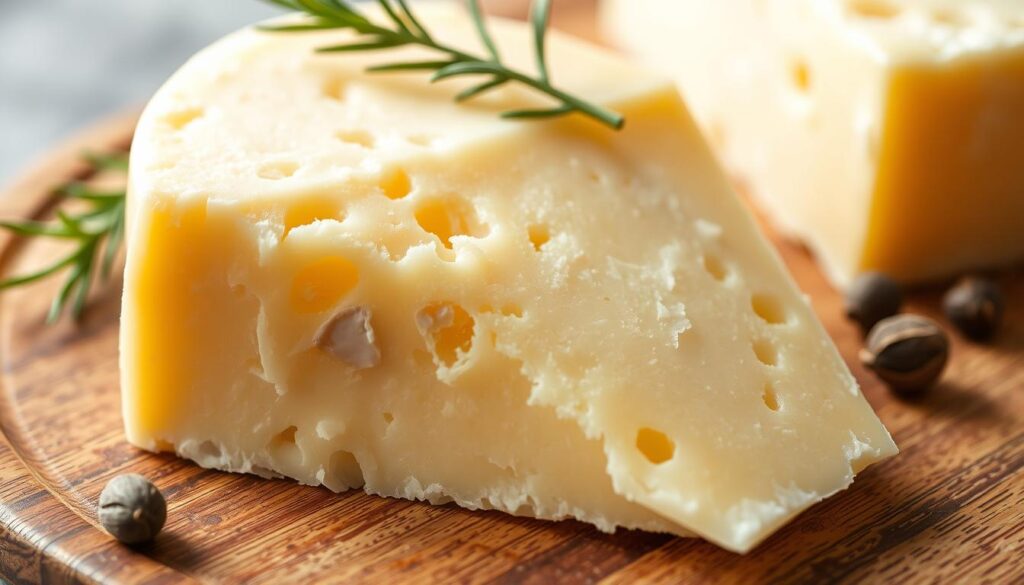
Pecorino Romano is a tasty and nutritious cheese that can fit into a healthy diet. Its unique mix of nutrients makes it a great choice for adding protein, calcium, and more to your meals20.
Conclusion: Embracing the Timeless Appeal of Pecorino Romano
Pecorino Romano is a timeless delight in Italian cuisine for centuries. Its unique flavor, texture, and versatility make it a must-have for cheese lovers22. As a DOP (Denominazione di Origine Protetta) cheese, its authenticity and quality are guaranteed. It has a minimum aging period of 5 months, with some varieties aged up to 1 year22.
Whether you want to enhance your pasta dishes or explore traditional Italian recipes, Pecorino Romano is perfect. It offers a timeless appeal that will delight your taste buds. By embracing its rich history and exceptional qualities, you can enjoy the best of Italian culinary traditions with this versatile cheese for years to come.
FAQ
What is Pecorino Romano Used For?
Pecorino Romano is a versatile cheese used in many dishes. It’s a key part of Italian cuisine, found in classics like Cacio e Pepe and Carbonara. It adds a sharp, salty taste to pasta, salads, soups, and stews.
What are the Best Pasta Dishes with Pecorino Romano?
Pecorino Romano is great in traditional pasta dishes like Cacio e Pepe and Carbonara. Its sharp flavor complements pasta and other ingredients. It’s also good on spaghetti, penne, or rigatoni for extra flavor and texture.
How to Store Pecorino Romano Cheese?
To keep Pecorino Romano fresh, store it in a cool, dry place. Wrap it in parchment or wax paper to prevent moisture. Keep it away from strong-smelling foods to avoid absorbing odors. These steps help you enjoy the cheese longer.
What is the Taste and Texture of Pecorino Romano Cheese?
Pecorino Romano has a sharp, salty taste with tangy and sweet notes. Its firm, granular texture is perfect for grating. As it ages, the flavor and texture become even more pronounced.
Is Pecorino Romano Cheese Strong?
Yes, Pecorino Romano is a strong cheese. Its aging process, lasting at least five months, enhances its sharp flavor and firm texture. This makes it a great addition to many dishes, adding depth to flavors.
What are the Best Recipes Featuring Pecorino Romano?
Pecorino Romano is great in many recipes, both traditional and modern. Try it in Cacio e Pepe, Carbonara, Pecorino Romano and Arugula Salad, Pecorino Romano Roasted Potatoes, and Pecorino Romano Baked Ziti. Its sharp flavor pairs well with pasta, vegetables, and more.

